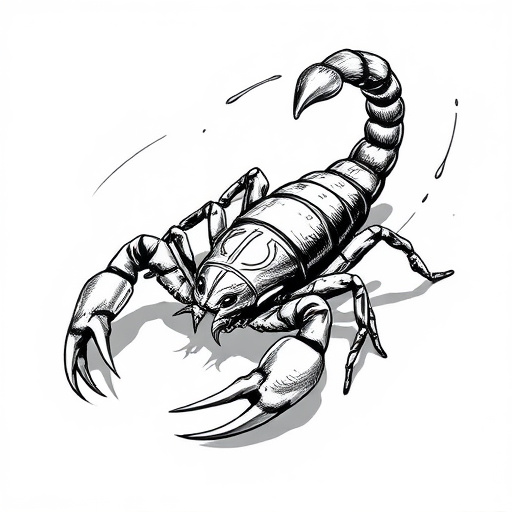Identifying common scorpion species in Vail, Arizona (scorpion control Vail AZ) is crucial for safe outdoor navigation and effective management. The region's ecosystem supports diverse scorpions like Androctonus australis and Parutarbus delansae, with unique behaviors and habitats. These nocturnal predators, found in rocky areas and cacti savannas, pose health risks, especially from the bark scorpion. Professional pest control services offer safe, eco-friendly scorpion control measures tailored to local species. A multi-faceted approach includes understanding behavior, regular inspections, sealing entry points, proper sanitation, and region-specific insecticides for successful long-term management.
Vail, Arizona, is home to a variety of scorpion species, some of which can pose health risks. This article provides an overview of the common scorpion species found in the area, explores their habitat and behavior patterns, discusses potential health hazards associated with scorpion stings, and offers effective scorpion control measures for residents of Vail, AZ. Learn how to identify these scorpions and protect your home and family from unwanted visitors through proper Scorpion Control Vail AZ methods.
- Identifying Common Scorpion Species in Vail, AZ
- Habitat and Behavior Patterns of Local Scorpions
- Health Risks and Scorpion Stings in Vail
- Effective Scorpion Control Measures for Your Home in Vail, AZ
Identifying Common Scorpion Species in Vail, AZ

Identifying Common Scorpion Species in Vail, AZ
When it comes to scorpion control in Vail, AZ, understanding the common species that inhabit your area is a crucial first step. Vail’s unique ecosystem supports several varieties of scorpions, each with distinct characteristics and behaviors. The most prevalent among them are the desert scorpions, such as the black-tailed scorpion (Androctonus australis), known for its striking appearance and relatively mild sting. These scorpions often dwell in rocky crevices and under debris, making them common sightings in the region’s arid landscapes.
Another notable species is the mountain scorpion (Parutarbus delansae), which has adapted to higher elevations and colder temperatures compared to its desert counterparts. This resilience makes it a year-round presence in Vail. While these scorpions may cause fear due to their appearance, most stings are not life-threatening to humans. Proper identification is key to effective scorpion control, ensuring that residents and visitors alike can enjoy the outdoors safely.
Habitat and Behavior Patterns of Local Scorpions

In Vail, Arizona, scorpions are an integral part of the local ecosystem, calling various habitats their home. These arachnids primarily inhabit areas with rocky outcrops, cacti, and creosote bush savannas, which provide both shelter and food sources. The most common species found in the region include the desert scorpion (Scorpescaurus cogni) and the giant desert hairless scorpion (Androctonus australis).
Behavior-wise, scorpions in Vail AZ display unique patterns adapted to their environment. They are primarily nocturnal creatures, becoming active during the cooler evening hours to hunt for prey such as insects, small rodents, and other arachnids. Their burrowing behavior allows them to escape extreme temperatures, with many species digging deep into the ground to create intricate tunnel systems. This habit also aids in scorpion control Vail AZ efforts by making it easier to locate and manage populations during targeted treatments.
Health Risks and Scorpion Stings in Vail

Scorpion stings in Vail, AZ, can pose significant health risks, particularly to children, the elderly, and individuals with certain medical conditions. While most scorpion species are relatively harmless, some local varieties, such as the bark scorpion (Androctonus australis), are known to deliver powerful venoms that may cause severe pain, swelling, and in rare cases, more serious complications like respiratory distress or organ failure. Prompt medical attention is crucial if you or someone else is stung by a scorpion.
Fortunately, effective scorpion control measures are available in Vail AZ to mitigate the risk of scorpion encounters and stings. Professional pest control services specialize in identifying and removing scorpions from homes and properties, utilizing safe and environmentally friendly methods tailored to local species. Regular inspections, sealing entry points, and proper sanitation practices can also significantly reduce scorpion populations. By combining these strategies, residents can create a safer environment and minimize the potential health risks associated with scorpions in Vail.
Effective Scorpion Control Measures for Your Home in Vail, AZ

In Vail, AZ, effective scorpion control involves a multi-faceted approach to ensure your home and property remain free from these pesky creatures. The first step is understanding their behavior and habitat. Scorpions thrive in dry, rocky areas, so maintaining proper hydration and removing potential hiding spots like piles of wood or debris around your house can significantly deter them. Regular pest inspections are also crucial; a professional can identify entry points and implement tailored solutions.
Additionally, sealing cracks and gaps in walls, windows, and doors is essential to prevent scorpions from entering. Using insecticides specifically designed for scorpions can help eliminate existing populations, but it’s important to consult with a local expert who knows the best products and application methods for your region. Remember, consistent maintenance and early intervention are key to effective scorpion control in Vail, AZ.
In Vail, Arizona, understanding the common scorpion species and their behaviors is crucial for both residents and visitors. By knowing where these scorpions habitat and what health risks they pose, you can take proactive steps for scorpion control in Vail AZ. Implementing effective prevention measures around your home can significantly reduce the likelihood of stings and ensure a safer environment. Remember, while these scorpions are a natural part of the local ecosystem, taking precautions is essential to minimize potential risks associated with their presence.
